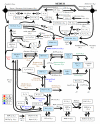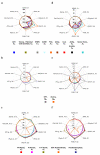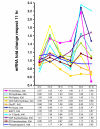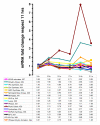Coordination of the dynamics of yeast sphingolipid metabolism during the diauxic shift
- PMID: 17974024
- PMCID: PMC2203994
- DOI: 10.1186/1742-4682-4-42
Coordination of the dynamics of yeast sphingolipid metabolism during the diauxic shift
Abstract
Background: The diauxic shift in yeast requires cells to coordinate a complicated response that involves numerous genes and metabolic processes. It is unknown whether responses of this type are mediated in vivo through changes in a few "key" genes and enzymes, which are mathematically characterized by high sensitivities, or whether they are based on many small changes in genes and enzymes that are not particularly sensitive. In contrast to global assessments of changes in gene or protein interaction networks, we study here control aspects of the diauxic shift by performing a detailed analysis of one specific pathway-sphingolipid metabolism-which is known to have signaling functions and is associated with a wide variety of stress responses.
Results: The approach uses two components: publicly available sets of expression data of sphingolipid genes and a recently developed Generalized Mass Action (GMA) mathematical model of the sphingolipid pathway. In one line of exploration, we analyze the sensitivity of the model with respect to enzyme activities, and thus gene expression. Complementary to this approach, we convert the gene expression data into changes in enzyme activities and then predict metabolic consequences by means of the mathematical model. It was found that most of the sensitivities in the model are low in magnitude, but that some stand out as relatively high. This information was then deployed to test whether the cell uses a few of the very sensitive pathway steps to mount a response or whether the control is distributed throughout the pathway. Pilot experiments confirm qualitatively and in part quantitatively the predictions of a group of metabolite simulations.
Conclusion: The results indicate that yeast coordinates sphingolipid mediated changes during the diauxic shift through an array of small changes in many genes and enzymes, rather than relying on a strategy involving a few select genes with high sensitivity. This study also highlights a novel approach in coupling data mining with mathematical modeling in order to evaluate specific metabolic pathways.
Figures







References
Publication types
MeSH terms
Substances
Grants and funding
LinkOut - more resources
Full Text Sources
Molecular Biology Databases

